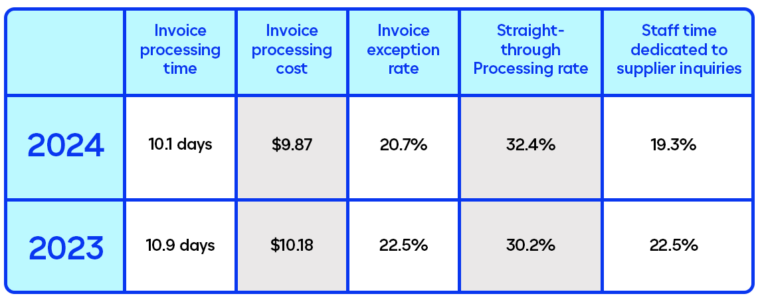Ardent Report Highlights AP Teams’ Incomplete Digital Shift
“Halfway There”: Ardent Report Highlights AP Teams’ Incomplete Digital Shift
Ardent Partners’ Report
Ardent’s “AP Metrics that Matter” report positions Accounts Payable at the forefront of an AI-driven revolution that many expect will solidify the department’s role as a strategic asset within modern enterprises. The report highlights numerous positives regarding process improvement, e-invoicing adoption, and efficiency gains. But it also prompts critical questions about whether businesses are genuinely prepared for a comprehensive digital transformation or merely content with incremental improvements.
Michael Creeden, Solutions Consulting Lead, US at Tradeshift gives us his take on this year’s findings. Download the full report here.
A Rising Star in Challenging Times
Not every superhero wears a cape to work. Just ask Lois Lane. But every business has a team of heroes who, like Clark Kent, are far more comfortable outside the limelight. The latest AP Metrics that Matter report once again casts a spotlight on the significant role of Accounts Payable (AP) in modern business environments.
Having earned their stripes through the pandemic, AP’s star has continued to rise through a challenging financial landscape marked by inflation, tightening monetary policies, and supply chain disruptions. This year 64% of business leaders recognized AP as highly valuable to their organizations, a similar figure to the previous year, and a significant shift from just five years ago (52%).
On the cusp of an AI-driven revolution
Perceptions of AP are shifting from a mere transactional function to activities that generate more value, such as managing cash flows and optimizing supplier payments. The adoption of Artificial Intelligence (AI) and predictive analytics promises to revolutionize AP processes further, enhancing efficiencies, reducing costs, and bolstering the strategic role of AP teams.
There is no questioning the ambition AP departments are showing when deploying these technologies, with three-quarters of finance leaders seeing investment in smarter systems as pivotal for elevating performance.
Progress across the board
Ardent’s latest report also offers plenty to cheer about, both in terms of the progress businesses are making in digitalizing core processes and in the efficiencies they are generating as a result.
Some of the most notable highlights from the report include:

Delving deeper into the story behind these improving metrics, a couple of key data points stand out. First, there’s the acceleration in the adoption of e-invoicing, an area where 79% of all AP organizations saw an increase last year. This goes hand in hand with the proportion of suppliers who have been enabled to send digital invoices, which the report puts at 48%.
Something doesn’t quite stack up, however. If the adoption of e-invoicing is rising among a broadening cohort of suppliers, then you’d expect the proportion of invoices coming through on paper to fall.
But that’s not what’s happening. This year’s report puts the proportion of invoices submitted electronically at 50.3%, a slight decrease on the year before, and largely consistent with the levels we’ve seen over the past five years. It’s here that a conflicting narrative begins to emerge which places a different perspective on the report. What’s going wrong?
Performance plateau: The long tail challenge
A year ago I said that it looked as if AP departments were running the risk of hitting a performance plateau. Looking at this year’s data only reinforces my view that we’re unlikely to see a ‘great leap forward’ anytime soon.
My read into the lack of movement in the paper vs digital split is that most businesses consider achieving 100% e-invoice submission an unattainable goal. So instead of viewing digitalization as a holistic process, all of their focus goes towards optimizing the 50% of the total invoice volume they view as within reach.
Granted, there’s some logic to an approach that focuses on optimizing processes among a cohort of suppliers where the transition to e-invoicing is comparatively painless. The more embedded digitalization becomes within this group, the better the results, hence the incremental improvements we see year over year in Ardent’s report. However this approach largely ignores the root cause of many of the challenges AP teams are trying to eliminate.
A lot of vendors in our space will tell you that the fastest way to achieve e-invoicing volume at scale is to focus on the top 20% of suppliers who account for 80% of your invoice volume. They’re not wrong in this regard. However, they often overlook that a substantial portion of exceptions and errors requiring manual intervention occur in the long tail of suppliers. You might dilute the problem, but the underlying issues will still be there. And you’ll still have to deal with them.
Persistent problems aren’t fully addressed
For all the outward signs of progress in this year’s report, most AP teams still have to perform some kind of manual intervention on around a fifth of their total invoice volume.
Complaints around invoice processing times and payment delays still dominate, and touchless e-invoicing rates seem stuck at around the 30% mark. None of this should be a surprise when AP teams appear to be settling at half-measures in terms of the digitalization goals.
This failure to tackle the last mile of digital transformation has real consequences.
For the second consecutive year, AP teams are prioritizing improvements in data and analytics while simultaneously saying they’re willing to forgo any insight from about half of their potential data sources.
And while we’ve seen a big rise in the number of businesses paying invoices electronically this year, any real benefit is going to be entirely canceled out by the 50% of invoices that are at risk of being delayed due to manual processing.
A Call to Action for Full Digital Transformation
Maybe I’m being overly critical. Transformation isn’t an overnight thing. But my impression from this year’s report is that there will never be a seismic year-on-year shift in any of Ardent’s metrics if enterprises are satisfied with 50% as a benchmark for success.
So what’s it going to take to make that ‘great leap forward?’
I don’t claim to have all the answers. But I will say enterprises 100% e-invoicing adoption should always be the goal. To get there enterprises need to understand that digitization efforts made to convert the most strategic, technically advanced suppliers, may not work for the long tail.
Offering the long tail flexible, easier ways to digitize their invoices, needs to be a focus. Enterprise should evaluate solutions that offer things like PDF connectors which allow suppliers to continue emailing invoices to the buyer but can map the structured PDF data to a common digital format (UBL in the case of Tradeshift). This reduces friction for the supplier, but still delivers the invoice data digitally to the buyer, and allows both parties to use a solution like Tradeshift to collaborate and ensure the invoice gets approved timely.
We built Tradeshift with a supplier-first philosophy because we understood that what works for buyers needs to work for suppliers. We’ve spent more than a decade helping many of the world’s largest organizations make ‘digital the default’ across the entire breadth of their supply chain. If you’re keen to understand how we achieved this and how you can too, then our Ultimate Guide to Supplier Onboarding is a great resource to get you started.
Is your business ready to take the great leap forward into the age of intelligent AI-driven accounts payable? Find out what’s separating Best in Class performers from the pack by downloading your copy of Ardent’s AP Metrics That Matter, here.
